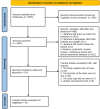Prevalence and influencing factors of cognitive frailty in Chinese maintenance hemodialysis patients: a systematic review and meta-analysis
- PMID: 40629315
- PMCID: PMC12235981
- DOI: 10.1186/s12882-025-04288-9
Prevalence and influencing factors of cognitive frailty in Chinese maintenance hemodialysis patients: a systematic review and meta-analysis
Abstract
Objective: Chronic kidney disease (CKD) has become a major challenge in global public health, and China has one of the heaviest burdens of CKD in the world, approximately 89.5% of patients require hemodialysis. Cognitive frailty (CF) is a condition characterized by physical frailty and cognitive impairment while excluding Alzheimer's disease and other dementias. CF is associated with adverse clinical outcomes, including hospitalization, disability, and increased mortality. The purpose of this study was to explore the prevalence and influencing factors of CF in Chinese maintenance hemodialysis (MHD) patients through systematic review and meta-analysis.
Methods: We searched PubMed, Cochrane Library, Web of Science, EMBASE, China National Knowledge Infrastructure (CNKI), Wanfang Database, Chinese Scientific Journal Database (VIP) and Chinese Biomedical Database (CBM) for epidemiological data on CF in Chinese patients undergoing MHD from inception to December 2024. A random-effects model was used to estimate the overall prevalence of CF in Chinese patients undergoing MHD. Odds ratios (OR) and 95% confidence intervals (CI) were used to estimate factors associated with CF in Chinese patients undergoing MHD. Stata 15.0 software was used to conduct systematic review and meta-analysis of the prevalence and influencing factors of CF in Chinese patients undergoing MHD.
Results: A total of 16 studies with 5690 Chinese patients undergoing MHD were included. The results of this meta-analysis showed that the prevalence of CF in Chinese patients undergoing MHD was 25%. The results of subgroup analyses showed that the frailty assessment tool (TFI) and education level (≥ College) may be sources of heterogeneity in the prevalence of CF in Chinese patients undergoing MHD. The meta-analysis results indicate that age (> 60, > 75), female, depression (HADS scale), malnutrition, triglycerides, waist circumference, stroke history, fall history, complications, CCI, comorbidities and dialysis age were risk factors for CF. High education level, calf circumference and serum creatinine level were protective factors for CF.
Conclusions: The prevalence of CF in Chinese patients undergoing MHD is high (25%). Therefore, this patient population necessitates early screening and targeted interventions with influencing factors.
Prospero registration number for this study: CRD42023493122CRD42023475424.
Keywords: China; Cognitive frailty; Influencing factors; Maintenance hemodialysis; Meta-analysis; Prevalence.
© 2025. The Author(s).
Conflict of interest statement
Declarations. Ethics approval and consent to participate: This study is mainly to collect data from various databases for analysis, so this is not applicable. Consent for publication: Not required. Competing interests: The authors declare no competing interests.
Figures
Similar articles
-
Prevalence and related factors of cognitive frailty in diabetic patients in China: a systematic review and meta-analysis.Front Public Health. 2023 Oct 19;11:1249422. doi: 10.3389/fpubh.2023.1249422. eCollection 2023. Front Public Health. 2023. PMID: 37927856 Free PMC article.
-
Prevalence and factors influencing fear of disease progression in stroke patients: a systematic review and meta-analysis with a focus on China.BMJ Open. 2025 Jun 6;15(6):e091605. doi: 10.1136/bmjopen-2024-091605. BMJ Open. 2025. PMID: 40480663 Free PMC article.
-
Cognitive Frailty as a Predictor of Future Falls in Older Adults: A Systematic Review and Meta-Analysis.J Am Med Dir Assoc. 2023 Jan;24(1):38-47. doi: 10.1016/j.jamda.2022.10.011. Epub 2022 Nov 21. J Am Med Dir Assoc. 2023. PMID: 36423679
-
Prevalence and Influence Factors of Cognitive Frailty in the Older Adult Patients Undergoing Maintenance Haemodialysis: A Multi-Centre Cross-Sectional Study.J Clin Nurs. 2025 Sep;34(9):3693-3703. doi: 10.1111/jocn.17527. Epub 2024 Nov 5. J Clin Nurs. 2025. PMID: 39497623
-
Direct-acting antivirals for chronic hepatitis C.Cochrane Database Syst Rev. 2017 Sep 18;9(9):CD012143. doi: 10.1002/14651858.CD012143.pub3. Cochrane Database Syst Rev. 2017. PMID: 28922704 Free PMC article.
References
-
- Expert Group of Shanghai Nephrology Clinical Quality Control Center Guidelines for Early. Screening, diagnosis, and prevention of chronic kidney disease (2022 Edition). Chin J Nephrol. 2022;38(5):453–64.
-
- Lv JC, Zhang LX. Prevalence and disease burden of chronic kidney disease. Adv Exp Med Biol. 2019;1165:3–15. - PubMed
-
- Zhang L, Wang F, Wang L et al. Prevalence of chronic kidney disease in China: a cross-sectional survey [published correction appears in Lancet. 2012;380(9842):650]. Lancet. 2012;379(9818):815–822. - PubMed
-
- Gu V, Zhou YJ, Ni ZH. Advantages and prospects of home Hemodialysis. Chin J Blood Purif. 2022;21(6):389–92.
-
- Shen Z, Ruan Q, Yu Z, Sun Z. Chronic kidney disease-related physical frailty and cognitive impairment: a systemic review. Geriatr Gerontol Int. 2017;17(4):529–44. - PubMed
Publication types
MeSH terms
Supplementary concepts
LinkOut - more resources
Full Text Sources
Medical








